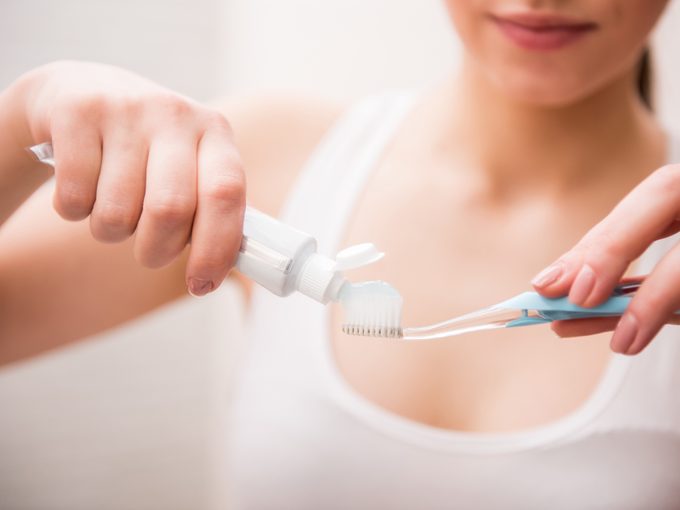Toothpaste Buying Guide: What to Look for When Shopping for Toothpaste
Overwhelmed by the options in the oral hygiene aisle? Use our toothpaste buying guide to find out which toothpaste is right for you and your family.

Buying a new tube of toothpaste can be a daunting task. With so many different formulas on the market, you may often find yourself standing in the drugstore trying to decide between an enticing vanilla-latte-flavoured variety and a tube with super-duper whitening power. What to choose? According to Dr. Euan Swan, spokesperson for the Canadian Dental Association (CDA), you don’t have to worry too much-most toothpaste formulas on the drugstore shelf will help protect your pearly whites.
“If you choose a product that you like the taste of so much that it encourages you to brush,” Swan says, “then it might be fair to say that any number of products in the marketplace will do the job for you.” After all, good oral hygiene goes far beyond the kind of toothpaste you select-proper diet, frequent brushing and flossing, and regular trips to the dentist all play an important role in maintaining your thousand-watt smile. However, we all need to decide on toothpaste at some point. Here’s some information on common label language to help you spend less time in the oral-care aisle and more time brushing.
Cavity-Fighting Toothpaste
All toothpastes fight cavities because they help to remove plaque when used correctly, says Dr. Hardy Limeback, head of Preventive Dentistry at the University of Toronto. But one thing to consider is that many toothpastes on the market today contain fluoride, which has been proven to protect tooth enamel from decay.
“Most people, if not all, can benefit from using a fluoridated toothpaste,” says Swan. The use of fluoride in oral hygiene is endorsed by over 90 national health organizations, including the CDA and Health Canada. Swan recommends that, at bare minimum, adults should look for toothpaste that contains this ingredient.
And when it comes to your kids, fluoride is important too-just make sure to keep an eye on things. As excessive swallowing of toothpaste by young children may result in dental fluorosis, a health condition caused by an overdose of fluoride, children under six years of age should be supervised during brushing and only use a small amount (e.g., a pea-size portion) of toothpaste. Children under three years of age should have their teeth brushed by an adult using only a smear of toothpaste. Talk to your dentist if you have any concerns about your kids’ toothpaste.
Whitening Toothpaste
Toothpastes that claim to whiten your teeth will help combat staining, but they won’t give you the same results as dental-office treatments or at-home whitening kits, both of which contain peroxide. “The whitening that a toothpaste does is principally cleaning the surface of the tooth to remove stains and to make the tooth whiter,” says Swan. Though some whitening toothpastes do contain a very low level of peroxide, most use an abrasive agent to shine up your pearly whites. If you feel you need help in removing surface discolouration on your teeth, you may want to consider a whitening toothpaste, but keep in mind that this product isn’t for everyone. “People with irritable bowel syndrome should stay away from abrasives,” says Limeback.
Antibacterial Toothpaste
These toothpastes contain a common antibacterial agent called triclosan, and claim to protect gums from bacterial infections like gingivitis. If you have a history of gingivitis, it may be a good choice for you, says Swan, and according to the CDA, triclosan is a useful ingredient in oral hygiene. However, keep in mind that its efficacy is still questioned by some experts. Consult your dentist on whether a toothpaste containing triclosan is right for you.
Natural Toothpaste
Toothpastes claiming to be all-natural can be found in most health food stores as well as mainstream drugstores. These formulations are often fluoride-free and use ingredients such as myrrh, peppermint oil and aloe to clean teeth and freshen the mouth. Though natural pastes can be pricier than the big-name brands, they may be a good choice for younger brushers or people with chemical sensitivities. “Natural toothpastes can be effective and can be safe to swallow,” says Limeback.
Toothpaste for Sensitive Teeth
If your mouth aches at the mere thought of an ice cream cone, you might want to consider using toothpaste for sensitive teeth. Many major brands make at least one sensitive-teeth formula, and according to Swan, most of them work in much the same way. “With sensitive teeth,” he says, “the gums have receded slightly, exposing the root. There is no enamel on the root so it can be stimulated by sweets or temperature changes, and that can affect the nerve inside the tooth. Toothpastes for sensitive teeth have the ability to block that stimulus from going through the root surface.”
The Canadian Dental Association’s Seal of Recognition
The CDA Seal of Recognition program is voluntary and not all toothpaste manufacturers go through the process of obtaining one. To get CDA approval for a particular formula, a manufacturer will submit data that proves that the toothpaste will perform as expected. “Looking for the seal is helpful to consumers, as it provides them with an increased level of confidence in their product selection,” says Swan. But remember that as the program is not mandatory for all manufacturers and the CDA does not perform its own product testing, toothpastes that do not bear the seal may perform just as well as those that do.
Related features:
6 Tips for Whiter Teeth
3 Foods that Can Prevent Gum Disease
5 Steps to Good Oral Health



